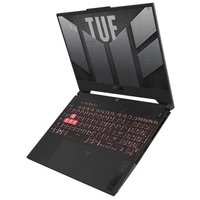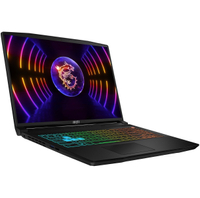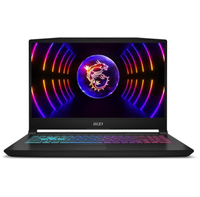The best Fall Prime Day gaming laptop deals under $1,500 I wish I had the money to buy
Just here fantasizing about what I'd do today if I had a chunk of cash just drop into my lap...

Asus TUF A17 | Nvidia RTX 4070 | AMD Ryzen 9 7940HS | 17.3-inch | 144Hz | 1080p | 16GB DDR5 | 1TB SSD | $1,799.99 $1,369 at Amazon (save $430.99)
If you're after a large-screen laptop for school with a little Triple-A gaming on the side, the TUF A17 will certainly deliver. It is only a 1080p panel, which is a bit of a shame, but its RTX 4070 will run pretty much everything at that resolution. It also has an 8-core, 16-thread Ryzen CPU that sports the 780M integrated graphics. That's the same as in all the latest handhelds so it can give decent gaming performance on the go and should offer more gaming battery life than running on the RTX 4070 when away from a plug socket.
Price check: Newegg $1,399.99
If I was labouring under the weight of one thousand and five hundred dollar bills, and was hankering after a new techie toy with which to dispense with my cash, then these are the Amazon Fall Prime Day gaming laptops I'd been throwing my money at. It's actually a pretty good haul, too, even if this Big Deal Days schtick hasn't provided really spectacular deals across the board.
There are quality laptops around the $1,500 mark, but also a selection of good quality machines for well under $1,000, too.
This Asus machine at the top is my pick, though. The Asus TUF A17 is on sale at Amazon for $1,369 right now, and that feels like a bit of a bargain for an RTX 4070 gaming laptop. It's not really that portable a notebook really, more of a desktop replacement with its 17.3-inch screen, so you're not going to be dropping it into a satchel for the morning commute.
But with that RTX 4070 backed up by a full Ryzen 9 7940HS processor and 16GB of DDR5 memory, it's got some serious productivity chops. It's only a 1080p 144Hz display, but it will happily output to a good gaming monitor should you wish to put some of those extra pennies towards another toy.
- We're curating all the best Amazon Prime Day PC gaming deals right here.
MSI Crosshair 15 | RTX 4070 | Intel Core i7 13620H | 16-inch | 144Hz | 1200p | 16GB DDR5 | 1TB SSD | $1,699.99 $1,389.90 Amazon (save $310.09)
We were surprised to see a new 16-inch RTX 4070-powered laptop for only $1,400. This Crosshair has a current-gen Intel CPU, so it's great for working and gaming. Also, the display has a 16:10 aspect ratio, so you get more field of view which is super useful in first-person shooters.
Price check: Best Buy $1,399.99
If you wanted a higher resolution, but with a smaller screen, then the $1,390 MSI Crosshair 15 is a decent option and another RTX 4070-toting gaming laptop, too. It is one of the budget brands of MSI, so don't expect the most stunning chassis, but at this price I'm more interested in the components at its heart. And it offers a really solid spec.
Then there are three really impressive sub-$1,000 gaming laptop deals that I wouldn't say no to, either. The super-cheap $870 Gigabyte G5 KF is the most affordable, but it does only come with a 512GB SSD and just 8GB of DDR4 memory. That would probably turn me off, to be honest.
Gigabyte G5 KF | Nvidia RTX 4060 | Intel Core i5 12500H | 15.6-inch | 1080p | 144Hz | 8GB DDR4 | 512GB SSD | $1,099 $859.99 at Newegg (save $239.01)
The Gigabyte G5 (see our review) is our favorite affordable gaming laptop, packing the RTX 4060 GPU for some serious 1080p gaming performance in a budget package. It's a smart spec that essentially uses an otherwise older specification with the simple addition of just the new Nvidia RTX 40-series graphics chip. The 512GB SSD is a bit miserly, but that is upgradeable. The 8GB of DDR4 memory is also upgradeable, and you'll want to bump it to 16GB, so this is a bit of a project buy.
Price check: Best Buy $919.99 | Amazon $879.99
MSI Katana 15 | 15-inch | RTX 4060 | Intel Core i5 12450H | 16GB DDR5 | 1TB SSD | $1,199 $949 at Newegg (save $250)
This is the RTX 4060 laptop to buy right now. For a little under $1,000, you can score a brand new RTX 4060 in a laptop that's not massively underpowered in some other way. Usually, we'd see manufacturers skimp on the SSD or RAM to get the cost down to this level, but here you're looking at a healthy 16GB of DDR5 and a 1TB NVMe drive. Lovely.
Price check: Amazon $1,399.99
Lenovo Legion Slim 5 | RTX 4060 | AMD Ryzen 7 7640HS | 16-inch | 144Hz | 1200p | 16GB DDR5 | 512GB SSD | $1,349.99 $949.99 at Best Buy (save $400)
Lenovo has been doing great things with laptops lately. We really rate Our pick as the best gaming laptop is a Lenovo, in fact. This isn't that laptop, but it's a slim version with a cut-down spec that will appeal to anyone actually looking to carry this around day-to-day. The only downside here is the slim SSD storage, but otherwise the spec looks great.
So it's a question of either the $949 MSI Katana 15 or the $950 Lenovo Legion Slim 5. Both have similar specs, rock an RTX 4060, and will make for a quality, affordable gaming laptop.
Of the two, though, I think I would absolutely go for the Lenovo—it's been smashing it out of the park recently in terms of new systems, and the combination of the Ryzen 7 Zen 4 mobile CPU and the 16-inch 16:10 screen would mean it gets my money.
Keep up to date with the most important stories and the best deals, as picked by the PC Gamer team.

Dave has been gaming since the days of Zaxxon and Lady Bug on the Colecovision, and code books for the Commodore Vic 20 (Death Race 2000!). He built his first gaming PC at the tender age of 16, and finally finished bug-fixing the Cyrix-based system around a year later. When he dropped it out of the window. He first started writing for Official PlayStation Magazine and Xbox World many decades ago, then moved onto PC Format full-time, then PC Gamer, TechRadar, and T3 among others. Now he's back, writing about the nightmarish graphics card market, CPUs with more cores than sense, gaming laptops hotter than the sun, and SSDs more capacious than a Cybertruck.






